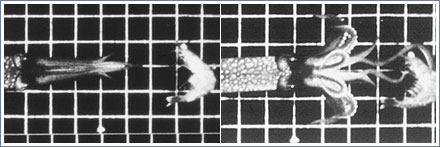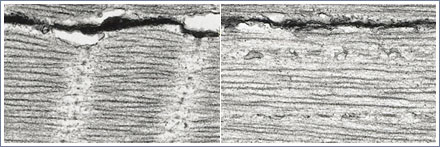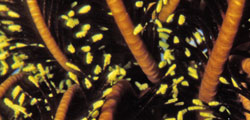Research
Diversity and Specialization of Muscle
Although the mechanisms of specialization of muscle have been well-studied in the vertebrates and in some arthropods, much less is known about how muscle is modified to alter its performance in invertebrates in general. I first became interested in this issue while analyzing the biomechanics of the arms and tentacles of squid (Loligo pealei), in particular, the extremely rapid strike of the tentacles. The tentacles, which depend on a muscular-hydrostatic mechanism, are elongated during prey capture by approximately 80% in only 20-40 milliseconds, reaching velocities of over 2 m s-1 and accelerations of approximately 250 m s-2. What specializations have evolved in the muscle responsible for the tentacular strike that allow such remarkable performance?

View the high speed video
An analysis of the biochemistry of the proteins of the myofilament lattice produced the surprising result that the biochemistry of the fast-contracting tentacle muscle fibers is remarkably similar to that of the slow-contracting arm muscle fibers. Examination of the arm and tentacle muscle by transmission electron microscopy, however, showed that the ultrastructure of the tentacle fibers is unlike that of all other muscle in cephalopods; the muscle fibers of the transverse muscle of the tentacles are cross-striated while virtually all other cephalopod muscle is the obliquely striated type and, of particular importance, the myofilament and sarcomere lengths of the tentacle fibers are unusually short. Because the shortening velocity of muscle is inversely proportional to resting sarcomere length, the short sarcomeres of the tentacle muscle result in high shortening velocity.

Transmission electron micrograph of transverse muscle of squid tentacle (left) and arm (right)
This is an exciting result because the mechanisms of specialization that I have observed in the squid fibers are thus in stark contrast to those observed previously in vertebrate muscle. In vertebrate muscle fibers, modulation of performance occurs primarily through variation in the isoforms of the proteins of the myofilament lattice, but the arrangement and the dimensions of the myofilaments (and sarcomeres) is constant. Recent work in collaboration with postdoc Dr. Justin Shaffer obtained amino acid and nucleotide sequences of the myosin heavy chain, providing more definitive evidence that squid muscle expresses identical myosin isoforms. My ongoing studies are designed to determine how widespread is this mechanism of specialization, not only in other cephalopod muscle, but in invertebrate muscle in general.
Selected Resources:
Kinematics of Prey Capture in Squid
Kier, W.M. and Van Leeuwen, J.L. (1997) A kinematic analysis of tentacle extension in the squid Loligo pealei. Journal of Experimental Biology 200: 41-53.
Specialization of Squid Tentacle Muscle
Kier, W.M. (1985) The musculature of squid arms and tentacles: Ultrastructural evidence for functional differences. Journal of Morphology 185: 223-239.
Kier, W.M. and Schachat, F.H. (1992) Biochemical comparison of fast- and slow-contracting squid muscle. Journal of Experimental Biology 168: 41-56.
Van Leeuwen, J.L. and Kier, W.M. (1997) Functional design of tentacles in squid: linking sarcomere ultrastructure to gross morphological dynamics. Philosophical Transactions of the Royal Society of London, Series B 352: 551-571.
Kier, W.M. and Curtin, N.A. (2002) Fast muscle in squid (Loligo pealei): contractile properties of a specialized muscle fibre type. Journal of Experimental Biology 205: 1907-1916.
Kier, W.M. and Schachat, F.H. (2008) Muscle specialization in the squid motor system. Journal of Experimental Biology 211: 164-169.
Shaffer, J.F. and Kier, W.M. (2012) Muscular tissues of the squid Doryteuthis pealeii express identical myosin heavy chain isoforms: an alternative mechanism for tuning contractile speed. Journal of Experimental Biology 214: 239-246.
Shaffer, J.F and Kier, W.M. (2016) Tuning of shortening speed in coleoid cephalopod muscle: no evidence for tissue-specific muscle myosin heavy chain isoforms. Invertebrate Biology. 135: 3-12.
Gilly, W.F., Renken, C., Rosenthal, J.J.C., Kier, W.M. (2020) Specialization for rapid excitation in fast squid tentacle muscle involves action potentials absent in slow arm muscle. Journal of Experimental Biology. 223, jeb218081. doi:10.1242/jeb.218081.
Van Leeuwen, J.L. and Kier, W.M. (2023) Predicting the effects of spatiotemporal modifications of muscle activation on the tentacle extension of squid. Frontiers in Bioengineering and Biotechnology. 11, 1193409. doi: 10:3389/fboe.2023.1193409.
Development, Specialization, and Evolution of Squid Muscle
Kier, W.M. (1991) Squid cross-striated muscle: the evolution of a specialized muscle fiber type. Bulletin of Marine Science 49: 389-403.
Kier, W. M. (1996) Muscle development in squid: ultrastructural differentiation of a specialized muscle fiber type. Journal of Morphology 229: 271-288.
Kier, W.M. and Thompson, J.T. (2003) Muscle arrangement, function and specialization in recent coleoids. Berliner Paläobiologische Abhandlungen 03: 141-162.
Thompson, J.T. and Kier, W.M. (2006) Ontogeny of mantle musculature and implications for jet locomotion in oval squid Sepioteuthis lessoniana. Journal of Experimental Biology 209: 433-443.
Thompson, J.T., Shelton, R.M. and Kier, W.M. (2014) The length-force behavior and operating length range of squid muscle vary as a function of position in the mantle wall. Journal of Experimental Biology. 217: 2181-2192.
Kier, W. M. (2016) The musculature of coleoid cephalopod arms and tentacles. Frontiers in Cell and Developmental Biology. 4:10.
Taylor-Burt, K.R., Kier, W.M., Olszewski-Jubelirer, J. and Thompson, J.T. (2018) Shape, size and structure affect obliquely striated muscle function in squid. Integrative and Comparative Biology. 58: 261-275.
Gilly, W.F., Renken, C., Rosenthal, J.J.C., Kier, W.M. (2020) Specialization for rapid excitation in fast squid squid tentacle muscle involves action potentials absent in slow arm muscle. Journal of Experimental Biology. 223, jeb218081. doi:10.1242/jeb.218081
Thompson, J.T., Taylor-Burt, K.R., and Kier, W. M. (2022) One size does not fit all: diversity of length-force properties of obliquely striated muscles. Journal of Experimental Biology. 226, jeb244949. doi: 10.1242/jeb.244949.

